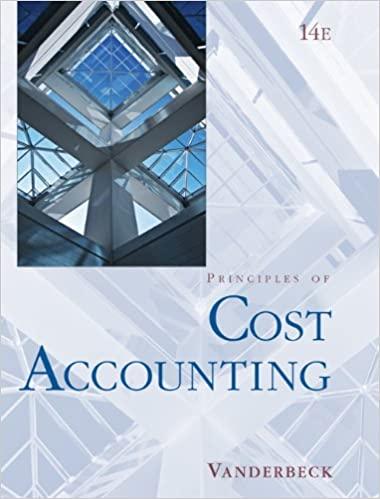Question
Nike Company produces an artificial cherry flavoring that passes through two production processes. Nike uses the weighted-average method to account for units and costs. Data
Nike Company produces an artificial cherry flavoring that passes through two production processes. Nike uses the weighted-average method to account for units and costs. Data for June for process 1 follow:
| % Completion | |||
| Units | Materials | Conversion | |
| WIP inventory, Jun 1 | 70,000 | 80% | 40% |
| WIP inventory, Jun 30 | 40,000 | 60% | 35% |
| Materials cost in WIP, Jun 1 | $ 62,260 |
| Conversion cost in WIP, Jun 1 | $ 19,620 |
| Units started into production | 310,000 |
| Materials cost added during Jun | $ 425,500 |
| Conversion cost added during Jun | $ 256,500 |
Question 1. What are the equivalent units for Jun for process 1?
Question 2. Compute the costs per equivalent unit for Jun process 1.
Questiion 3. Determine the total cost of ending WIP inventory in Jun.
Question 4. Determine total cost of units transferred to process 2 in Jun.
Nestle Company makes rubber cement. Data for Nestle's Mixing department is given below. Assume Nestle uses the weighted-average method in its process costing system.
| % Complete | |||
| Units | Materials | Conversion | |
| Ending WIP | 45,000 | 60% | 35% |
| Materials | Conversion | |
| Cost/EU | $ 6.50 | $ 9.50 |
Question 5. Determine the total cost assigned to the ending WIP inventory for the Mixing department.
GM Company manufactures two products - Product Y and Product Z. The company uses a plantwide overhead rate based on direct labor-hours. It is considering implementing an activity-based costing (ABC) system that allocates all of its manufacturing overhead to four cost pools. The following additional information is available for the company as a whole and for Products Y and Z.
| Activity Cost Pool | Acitivity Measure | Estimated Overhead Cost | Expected Activity | |
| Machining | Machine-hours | 300000 | 10000 | MHs |
| Machine setups | Number of setups | 100000 | 400 | setups |
| Production design | Number of products | 80000 | 2 | products |
| General factory | Direct labor-hours | 450000 | 15000 | DLHs |
| Activity Measure | Product Y | Product Z |
| Machining | 6000 | 4000 |
| Number of setups | 150 | 250 |
| Number of products | 1 | 1 |
| Direct labor-hours | 9500 | 5500 |
| Units Produced | 20000 | 8000 |
Question 6. Using the ABC system, how much total manufacturing overhead cost will be assigned to Product Y and Product Z?
Question 7. Using the plantwide overhead rate, what percentage of the total overhead cost is assigned to Product Y? What percentage is assigned to Product Z?
Step by Step Solution
There are 3 Steps involved in it
Step: 1

Get Instant Access to Expert-Tailored Solutions
See step-by-step solutions with expert insights and AI powered tools for academic success
Step: 2

Step: 3

Ace Your Homework with AI
Get the answers you need in no time with our AI-driven, step-by-step assistance
Get Started


